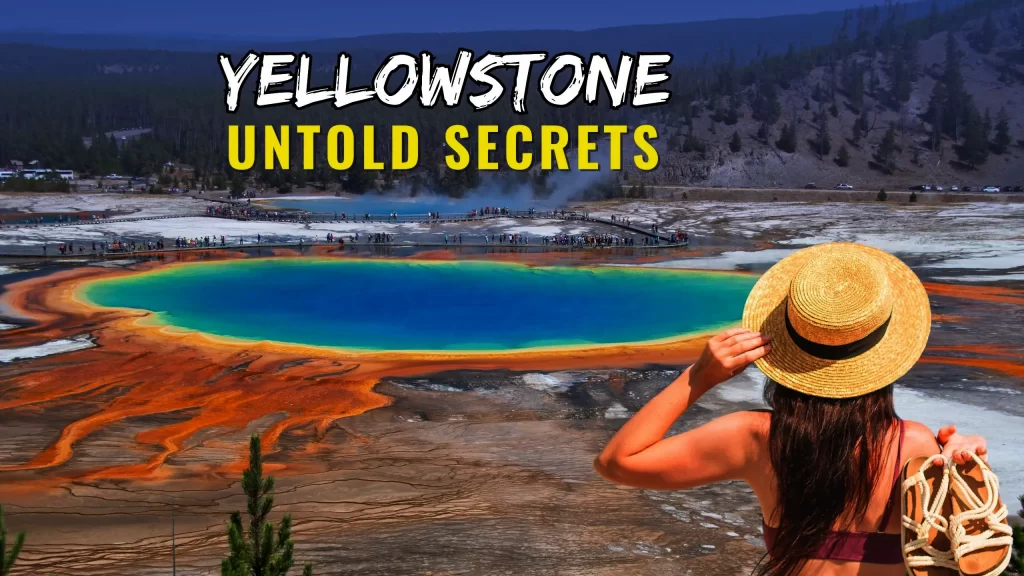Yellowstone National Park is one of the most visited and cherished destinations in the United States. Spanning across Wyoming, Montana, and Idaho, this vast wilderness is known for its breathtaking landscapes, geothermal wonders, and diverse wildlife. But beyond the tourist attractions, Yellowstone holds untold secrets that make it even more fascinating. From hidden geysers to ancient history buried beneath its surface, let’s uncover why Yellowstone is truly one of a kind.
Established in 1872 and located primarily in Wyoming, Yellowstone National Park was America’s first national park. To this day, Yellowstone remains one of the country’s most popular national parks with millions of annual visitors. Yellowstone spans almost 3,500 miles, and extends into parts of Montana and Idaho, making it one of the largest national parks in the US.
Why is Yellowstone So Famous?
Yellowstone National Park sits on top of a dormant volcano and is home to more geysers and hot springs than any other place on earth. Wonders abound at this truly unique national park, from sites like the Yellowstone Grand Canyon to wildlife like America’s largest buffalo herd, grizzly bears, and wolves. Approximately 50 percent of the world’s hydrothermal features are at Yellowstone National Park, creating an effect that makes the ground appear to be on fire. The most famous of all the geysers is Old Faithful, one of the most popular and recognized natural wonders in the United States.
You May Read
The Supervolcano Beneath Yellowstone
One of the most intriguing secrets of Yellowstone is the massive supervolcano lying beneath its surface. Unlike ordinary volcanoes, Yellowstone’s caldera is a gigantic underground chamber of molten rock. Scientists estimate that the last major eruption occurred over 640,000 years ago, but the supervolcano remains active today.
Evidence of this can be seen in the park’s thousands of hot springs, geysers, and fumaroles, which serve as pressure release valves for the immense geothermal activity below. While there’s no immediate danger of an eruption, experts closely monitor seismic activity to detect any changes.
Hidden Geysers and Thermal Pools Only a Few Have Seen
While Old Faithful is the park’s most famous geyser, Yellowstone has more than 500 active geysers, making it home to over half of the world’s geysers. Some remain hidden from the public due to their remote locations or unpredictable eruptions.
Among these are the Morning Glory Pool, which has changed colors over the years due to bacteria and minerals, and the Giantess Geyser, which erupts only once every few years but can reach up to 200 feet high. Explorers and scientists continuously discover new geothermal features, proving that Yellowstone is still evolving.
The Underground World: Caves, Lava Tubes, and a Hidden Lake
Beneath the famous landscapes of Yellowstone, there is an unseen world waiting to be explored. The park contains deep caves, lava tubes, and even hidden lakes that few have ever set foot in. One such mystery is Dragon’s Mouth Spring, a steaming cavern where water violently churns and roars, making it seem like an actual dragon is breathing beneath the earth.
Another secret wonder is Yellowstone Lake’s underwater geysers, where hot water surges from the lakebed, creating an otherworldly ecosystem. These hidden places hold clues to Yellowstone’s ancient past and may even provide insights into Earth’s geothermal future.
The Mysterious Sounds of Yellowstone
Visitors to Yellowstone have reported hearing eerie sounds at night—low-frequency hums, unexplained howls, and even what sounds like whispering voices. While some of these noises can be attributed to the park’s abundant wildlife, others remain unexplained.
Scientists believe some of these sounds might come from deep within the earth, as geothermal activity can create seismic waves that manifest as audible tones. There have also been tales of Native American legends about spirits inhabiting the geysers and rivers, adding to the park’s mystical allure.
A Place Older Than Time: Ancient Fossils and Prehistoric Discoveries
Yellowstone is not just a natural wonderland; it is also a window into prehistoric history. Fossils found in the park indicate that it was once home to ancient creatures like mastodons and prehistoric bison. In Specimen Ridge, an entire petrified forest stands as evidence of volcanic eruptions that buried trees in ash millions of years ago.
Archaeologists have also discovered tools and artifacts from early human civilizations dating back over 11,000 years, proving that Yellowstone has been a place of mystery and survival since the dawn of time.
Wildlife Secrets: The Return of the Wolves and the Unseen Predators
Yellowstone’s diverse ecosystem is home to some of the most iconic wildlife in North America. However, one of its biggest secrets is the critical role that wolves play in maintaining the balance of the park. Wolves were reintroduced in 1995 after being eradicated for decades, and their return transformed the ecosystem.
By controlling elk populations, they allowed overgrazed areas to recover, leading to healthier rivers, more trees, and a surge in biodiversity. But beyond the famous wolves, there are other elusive creatures in Yellowstone, such as the wolverine, one of the rarest and most secretive predators in the wild.
The Phantom Geyser: A Geyser That Disappeared for 100 Years
One of Yellowstone’s strangest mysteries is the story of the Steamboat Geyser, the world’s tallest active geyser. Unlike Old Faithful, which erupts on a predictable schedule, Steamboat Geyser can go silent for decades before suddenly erupting again.
For nearly 100 years, it remained mostly dormant, but in 2018, it suddenly roared back to life, with over 150 eruptions recorded in the past few years. Scientists are still studying why it behaves so unpredictably, making it one of Yellowstone’s biggest geothermal enigmas.
Lost and Forgotten: Hidden Human Settlements in Yellowstone
While Yellowstone is known for its natural beauty, few people realize that it also holds forgotten remnants of human settlements. In the late 1800s, small communities existed within the park, including mining camps, lodges, and even a stagecoach station.
Some of these settlements were abandoned and reclaimed by nature, leaving behind only ruins and ghostly traces of their existence. Rangers and historians occasionally uncover remnants of these lost communities, adding another layer of mystery to Yellowstone’s rich history.
The Future of Yellowstone: Will It Change Forever?
As one of the most carefully protected parks in the world, Yellowstone continues to evolve. Scientists warn that climate change, increasing tourism, and shifting geothermal activity could alter the park in ways we can’t yet predict.
Rising temperatures have already started affecting wildlife migration patterns, and changes in geyser activity suggest that the underground volcanic system is shifting. While Yellowstone will always be a place of wonder, its future remains uncertain, making it even more crucial to protect and preserve its untold secrets for generations to come.
Yellowstone holds more secrets than most visitors will ever realize. The next time you visit, take a moment to look beyond the obvious—you might just discover a secret of your own.
FAQs
1. Why is Yellowstone National Park so famous?
Yellowstone is famous for being the first national park in the world, established in 1872. It is known for its geothermal features, including the iconic Old Faithful geyser, diverse wildlife, and breathtaking landscapes.
2. What makes Yellowstone unique?
Yellowstone sits atop a supervolcano, creating one of the world’s most active geothermal regions. It has over 10,000 hydrothermal features, including geysers, hot springs, mud pots, and fumaroles.
3. Is Yellowstone really a supervolcano?
Yes, Yellowstone is located over a massive caldera, which is one of the largest active volcanic systems on Earth. Although an eruption is unlikely in our lifetime, the park’s geothermal activity is fueled by this volcanic system.
4. What are some hidden secrets of Yellowstone?
Yellowstone has hidden gems like the Grand Prismatic Spring, Lamar Valley (known as the “Serengeti of North America”), and the Yellowstone River’s underground “Black Pool” that changes colors due to heat-loving bacteria.
5. What wildlife can you see in Yellowstone?
Yellowstone is home to grizzly bears, black bears, wolves, elk, bison, and bald eagles. The park has one of the largest free-roaming bison herds in the U.S.
6. What is the best time to visit Yellowstone?
The best time to visit depends on your preference. Summer (June–August) offers great weather but is crowded. Spring and fall have fewer tourists and more active wildlife. Winter is perfect for unique experiences like wolf-watching and snowshoeing.
7. How long does it take to explore Yellowstone?
A full experience typically requires 3–5 days. However, if you’re short on time, you can see major attractions like Old Faithful, Grand Prismatic Spring, and Yellowstone Lake in 1–2 days.
8. Is it safe to visit Yellowstone?
Yes, but visitors should follow safety guidelines. Wildlife encounters, geothermal areas, and unpredictable weather can be dangerous if not approached with caution.
9. Can you stay inside Yellowstone National Park?
Yes, there are lodges, cabins, and campgrounds inside the park. Booking in advance is recommended, especially during peak seasons.
10. What are some must-visit places in Yellowstone?
Top attractions include:
- Old Faithful Geyser
- Grand Prismatic Spring
- Mammoth Hot Springs
- Lamar Valley (wildlife spotting)
- Grand Canyon of Yellowstone
- Yellowstone Lake







